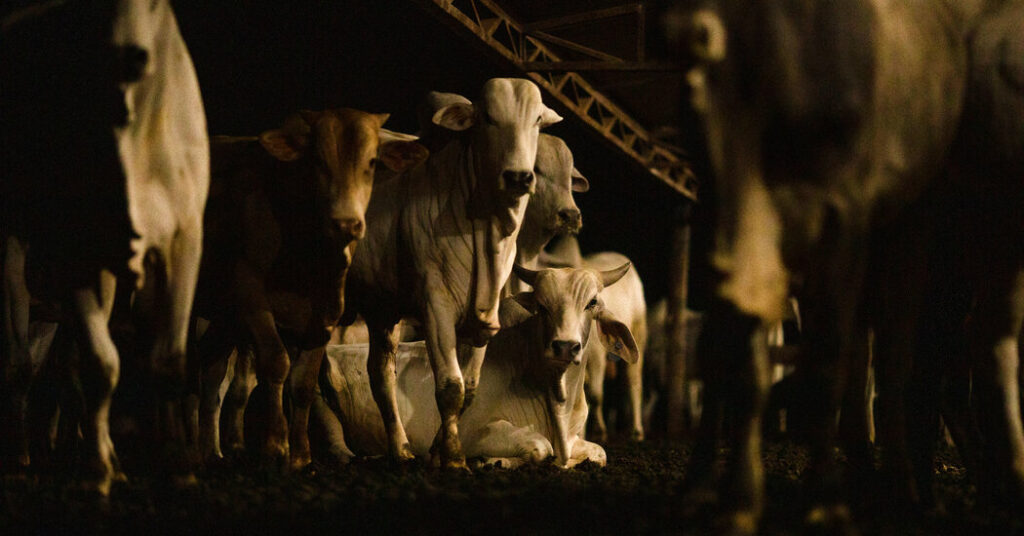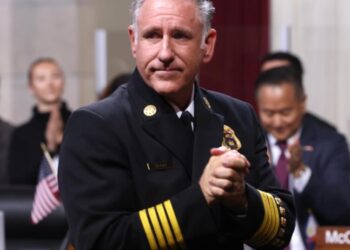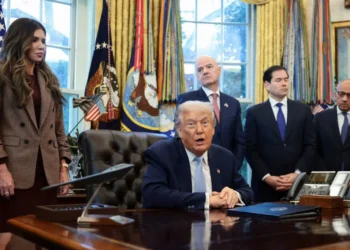In this edition, we journey to the Himalayas to study melting glaciers and explain two new legal settlements that could change the way beef is marketed to climate-conscious consumers. But first, let’s get caught up:
-
David Richardson resigned as acting administrator of the Federal Emergency Management Agency, injecting even greater uncertainty into the Trump administration’s plans to overhaul the federal role in disaster response.
-
The Trump administration proposed to significantly limit the Environmental Protection Agency’s authority to limit pollution in wetlands, rivers and other bodies of water across the country. The proposed rule could strip federal protections from millions of acres of wetlands and streams, potentially threatening sources of clean drinking water for millions of Americans.
‘Climate-friendly’ beef now has to prove it
As two of the world’s biggest meat companies began peppering marketing materials with phrases like “climate smart” and “net zero” over the last few years, climate and food industry experts thought it sounded too good to be true.
Last year, the New York attorney general’s office and the Environmental Working Group, a nonprofit organization, filed lawsuits against JBS Foods U.S.A. and Tyson Foods over the claims, accusing the companies of “greenwashing.”
Two settlements announced this month would force the companies to walk back some of their environmental claims. But this week in Brazil, where JBS’s parent company is headquartered, ranchers and meatpackers have descended on the U.N.’s annual global climate conference to make the case for a “low-carbon” label for beef products.
The developments highlight the tension between food companies eager to promote climate efforts and advocates who want to make sure the industry’s messaging passes a smell test. Here’s what to know.
Beef’s heavy environmental toll
Thanks in large part to the immense amount of land required to grow cattle feed, beef has some of the highest environmental costs of any food. Cows also belch methane, a highly potent greenhouse gas responsible for up to a third of global warming.
So when Tyson Foods began marketing “climate-friendly” beef and advertising plans to stop adding greenhouse gases to the atmosphere, achieving net-zero emissions by 2050, experts were skeptical. According to the company, it produces about 20 percent of its beef, pork and chicken in the United States. Critics called its green claims unclear.
“Our concern was that they didn’t do enough publicly to explain what those definitions meant — what climate-smart beef actually meant, how they were actually getting to net zero,” said Caroline Leary, general counsel for Environmental Working Group.
JBS’s promise to reach its own net-zero milestone raised even more eyebrows. Attorney General Letitia James of New York sued the company’s U.S. subsidiary last year, arguing that the company’s statements were misleading well-intentioned consumers.
The settlements
Both cases settled this month. For the next five years, an independent expert will have to verify Tyson’s climate commitments before the company can continue to make certain advertising claims about its beef products or emissions. In the meantime, the company will need to remove phrases like “climate smart” and “climate friendly” from beef marketing materials.
Under its agreement, JBS Foods USA must characterize plans to reach net-zero emissions by 2040 as a “goal” rather than a “pledge” or a “commitment.” Going forward, if the company says it is taking steps to reduce greenhouse gas emissions, it has to be explicit about those actions. JBS Foods USA will also pay $1.1 million to support sustainable agriculture in New York state.
In a statement, a Tyson Foods spokeswoman said the company is taking a holistic approach to identifying opportunities to reduce greenhouse gas emissions across the supply chain. JBS said it is committed to sustainable agriculture. Both companies said the settlements are not an admission of wrongdoing.
A lesson from Listerine
It’s unclear how the legal agreements will affect ongoing efforts to market beef as a low-emissions product. When it comes to false advertising, individual lawsuits don’t tend to lead to big, industrywide changes, said Rebecca Tushnet, a Harvard law professor who focuses on advertising.
But sustained enforcement campaigns can make a big difference, she added.
Take Listerine, for example. Throughout much of the 20th century, the manufacturer of Listerine claimed its mouthwash treated and prevented colds. This wasn’t strictly true, and in the 1970s, the Federal Trade Commission cracked down. The mouthwash maker was ordered to spend $10 million, the rough equivalent of one year’s Listerine marketing budget, on “corrective” advertising to spread the message that its product didn’t actually treat colds.
That the Listerine brand no longer carries a cold medicine connotation is a success, Tushnet said. “Eventually, once the false advertising is removed from the market, things do tend to get better,” she said.
Misleading advertising from meat companies is what the JBS Foods USA and Tyson Foods lawsuits are intended to prevent. The point of the beef lawsuits is not so much to force all beef companies to change their business models, said Kelsey Eberly, a senior staff attorney at the legal advocacy organization FarmSTAND who worked on the Tyson case.
It’s more about making sure that a person buying a hamburger doesn’t think it has the same environmental footprint as a black bean burger.
“It’s a warning to other large companies that you cannot just claim that you’re magically going to erase your greenhouse gas emissions,” Eberly said. “You have to come with the goods if you’re going to claim meaningful climate improvement.”
Nepal’s melting glaciers are creating new lakes — and threatening villages
The view from the moraine behind the Sherpa village of Gokyo, at an altitude of 15,550 feet, should have taken my breath away. The 360-degree views of Nepal’s jagged, snow-draped peaks were stunning, but I wasn’t looking at the mountains.
Instead, earlier this year I was staring at a meltwater lake on the Ngozumpa, Nepal’s longest glacier. On my first trip to the northeastern Nepalese region known as Khumbu in 2005, the lake was a ribbon-shaped puddle that I could step across. But by this May, it stretched nearly a third of the way across the Ngozumpa’s width.
In August 2024, a similar lake on another glacier careened through the Sherpa village of Thame. While luckily no one died, the flood destroyed the village’s school, medical clinic, several lodges and homes.
As a geological scientist, I’ve spent the last 20 years with a front-row seat to the global climate crisis, but I was publishing in academic journals, read only by scientists. I returned to Nepal this summer not as a scientist, but as a photojournalist on assignment for The Times.
I was there to document how soaring temperatures are transforming Nepal’s glaciers into dangerously unstable lakes, like the ones I had watched and studied as they spread across the Ngozumpa and other glaciers for two decades. They have emerged as a new threat facing Sherpa villages.
Studying a glacial lake
For 3½ weeks spread across May and June, I tagged along with the glaciologists Scott Watson and Lauren Rawlins as they trekked through the Khumbu to systematically map the depths of meltwater lakes in the three main valleys near Mount Everest. They’re part of a team that’s creating a new database that will help Nepal to better understand and manage its growing risks from glacier lakes.
With no roads, we trudged along dusty trails for more than 125 miles and slogged across mountain passes that reached higher than 18,000 feet. Along the way, I met the people who live in the villages below these lakes. I stood in the mud-encrusted ruins of Thame’s school and I talked to the children and teachers who ran for their lives as a glacial lake barreled through their classrooms.
There will be more of these floods, and bigger ones, in the future, as temperatures across the Himalayas continue to rise while human activity adds greenhouse gases to the atmosphere. And while there are engineering efforts underway to reduce the threats posed by Nepal’s largest and most dangerous lakes, lowering every lake would be prohibitively expensive. That’s why the work of scientists like Dr. Watson and Dr. Rawlins is so vital. The data they’re collecting will help Nepal prioritize lakes for expensive mitigation projects.
You can read more, and see a recreation of the path of the flood that hit Thame, in our article.
This work was supported by a grant from the Pulitzer Center.
More climate news from around the web:
-
Big technology companies are buying so many carbon removal credits, Reuters reports, that it has led to a global shortage of high-quality carbon products.
-
Reuters also reports on a video message from Pope Leo that was played at the sidelines of the U.N. climate summit: “The Paris Agreement has driven real progress and remains our strongest tool for protecting people and the planet,” he said in the video. “But we must be honest: it is not the Agreement that is failing, we are failing in our response.”
-
Heatmap News explains how an electricity rate freeze, like the one proposed by New Jersey Governor-elect Mikie Sherrill, might work.
Thanks for being a subscriber.
Read past editions of the newsletter here.
If you’re enjoying what you’re reading, please consider recommending it to others. They can sign up here. Browse all of our subscriber-only newsletters here. And follow The New York Times on Instagram, Threads, Facebook and TikTok at @nytimes.
Reach us at [email protected]. We read every message, and reply to many!
Claire Brown covers climate change for The Times and writes for the Climate Forward newsletter.
The post ‘Climate-Friendly’ Beef Now Has to Prove It appeared first on New York Times.




